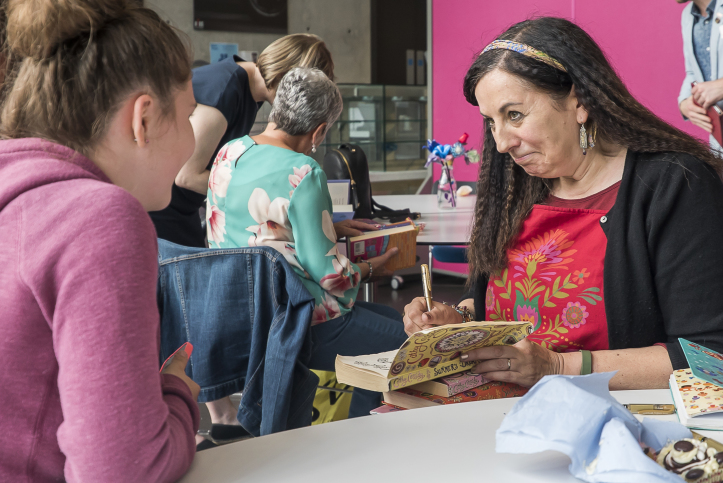This is a really fascinating series. There’s not one contribution which hasn’t made me a little envious. But the really nice thing is to see the diversity of places people write.
Today’s contribution is from Colin Falconer. I think you’ll enjoy it.
WRITING: A STUDY IN STUDIES
Colin Falconer
It is a truth universally acknowledged that every writer, in search of a small fortune, needs a quiet place to work.
Some authors also need a 2H pencil and a bookshelf surrounded by their own personal library with a thesaurus, the Complete Works of William Shakespeare and a dog-eared copy of William Strunk Junior’s ‘Elements of Style’.
I am not one of those writers.
I can and will write anywhere. All I need is something to write with. I prefer a laptop. But a pen will do. A blunt piece of crayon. A Sharpie. Lock me in a cell with a knife and I will scrawl on the walls with my own blood.
For a short while anyway, until it runs out.
But every writer needs a study, some special place to work, right? A place where they can pose with a profound look for author photos?
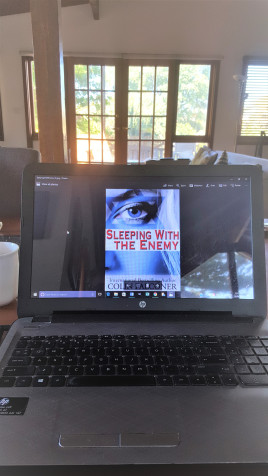
‘Where I work now. The puppies wouldn’t keep still for the photo.’
I had one of those, once. It was the size of a basketball court. It was very nice but I don’t miss it. Over the years, I have worked at various kitchen benches; at a dining room table in a rain forest with a python stalking the busk turkeys on the veranda; on a balcony with a view of the Sagrada Familia and a little box in Sydney with a view of a wall.
All the same to me.
At this very moment, there are two puppies brawling in the corner with a cocker spaniel going psycho in the other. For me this is bliss.
In truth, I take my study with me everywhere. Here is a picture: 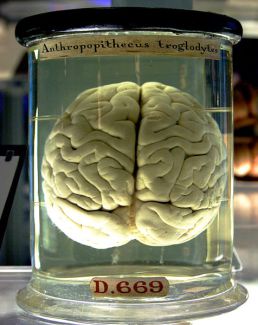 Photo credit: Gaetan Lee
Photo credit: Gaetan Lee
Actually, that’s not even my brain. That belongs to a chimpanzee, so it’s probably twice the size of mine. But you get my point.
All I need to work, anywhere, is my weird, strangely-wired mind that looks at a photograph in a magazine or overhears a conversation and immediately finds a narrative. It got me into a lot of trouble at school.
“Falconer! (Weird that Mrs Burns knew my pen name in grade five, but teachers are psychic like that.) Falconer, explain to the class what were we just saying about how clouds form?”
*** dead silence. Falconer is still gazing out of the window, oblivious ***
The shape of things to come.
I have no routine – but I am not typical, it seems. Haruki Murakami is a Japanese writer whose work has been translated into 50 languages. He gets up at four every morning, writes for eight hours then runs for ten kilometres and swims 1500 metres. EVERY SINGLE DAY UNTIL HE FINISHES THE BOOK. He compares writing to survival training.
(What’s Japanese for “Holy Shit!”)
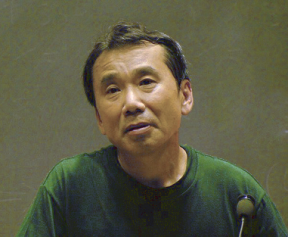
Haruki Murakami: photo courtesy ‘wakarimasita of Flickr’
Maya Angelou used to rent a room in a local hotel. She had them take down all the pictures and stocked it with a Roget’s Thesaurus, a dictionary and a Bible. Housekeeping were not allowed in, they had to slip notes under her door: You haven’t changed the bed sheets for 2 months, we’re worried they might go moldy. She didn’t even SLEEP there. She went home in the afternoons to edit what she wrote there in the morning.
Starting to feel halfway normal now? Me too.
Hemingway and Nabokov used to stand up to write; Agatha Christie and Victor Hugo wrote in the bath. (I tried that but spent all my time playing submarines.) Mark Twain and – wait for it – Amy Lowell smoked cigars.
Edgar Allan Poe wrote with his cat on his shoulders. It kept the ravens away, I suppose. Charles Baudelaire composed essays and poetry with a pet bat in a cage on his desk.
Byron, of course, said he had to have sex in order to write. While he was writing? Don’t know. Maybe.
Honore de Balzac used to drink 50 cups of coffee a day. (Beat me by one!)
Søren Kierkegaard would pour sugar into a coffee cup until it was above the rim. Then he dissolved the white pyramid with strong black coffee and then gulped the whole thing down in one go. Cool.
Others needed even stronger stimulants. Samuel Taylor Coleridge took two grains of opium before writing. So did Keats. Robert Louis Stevenson wrote sixty thousand words in six days using cocaine. A real Jekyl and Hyde characters, our Bob.
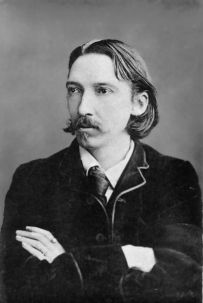
‘Robert Louis Stevenson. Note the dilated pupils.’
John le Carré wrote his debut novel on his ninety minute scommute into London, Sir Walter Scott composed while on his horse, Gertrude Stein wrote in the front seat of her model T Ford. D.H. Lawrence preferred to write under trees.
John, Walt and Gertie were the normals. Benjamin Franklin insisted on working naked while Edith Wharton wrote in bed; when she was finished with a page she let it flutter to the floor – where it was retrieved by her maid for her secretary to type up.
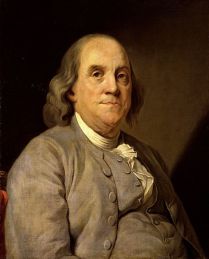
‘Ben Franklin, wearing clothes.’
Dame Edith Sitwell liked to lie down when she wrote as well – in a coffin.
At last I see what I have been doing wrong all these years. I’m off into town now to get a box of Cubans and a raven, maybe try and score some coke, then pop into the funeral parlour and order a catafalque.
Yep. I can feel a bestseller coming on already.
Thanks very much for this, Colin and especially for not giving us the picture of ‘Ben Franklin, naked.’You’ve shown how it’s possible to write anywhere the imagination takes you (and some where maybe it shouldn’t have) and still produce good books.
You can find out more about Colin and his good books by following the links below:
Falconer Facebook Club: http://bit.ly/2eOYEHu
my web page: http://colinfalconer.org
Amazon page for new book: https://www.amazon.com/dp/B06Y3J3297
Advertisements Share this:

